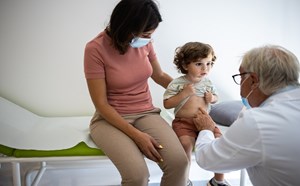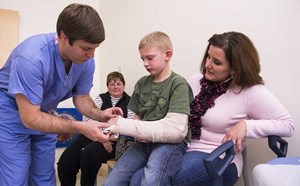
Severe Acute Respiratory Syndrome Coronavirus-2 and Multi-system Inflammatory Syndrome in Children: Preliminary Reports
What is the Multi-system Inflammatory Syndrome in Children (MIS-C)?
Most children infected with Severe Acute Respiratory Syndrome Coronavirus-2 (SARS-CoV-2) have a mild course of illness.1 However, there have been recent reports of a number of children developing a condition with similarities to Kawasaki disease (KD) and toxic shock syndrome (TSS) within epicenters of the SARS-CoV-2 outbreak, including over 200 children in New York, Italy, and the United Kingdom. This condition has been named the Multisystem Inflammatory Syndrome in Children (MIS-C). As of May 14, 2020, the Centers for Disease Control and Prevention (CDC) recommends reporting of suspected cases to their local or state health departments. This article is a brief summary of preliminary reports on MIS-C to serve as a primer for emergency clinicians.
How is MIS-C diagnosed?
Current case definitions of MIS-C from the World Health Organization (WHO) and CDC vary slightly (Table).2,3 Definitions incorporate both clinical and laboratory findings.
Table. *Comparison of WHO and CDC case definitions of MIS-C.
Type
WHO Definition
†CDC Definition
Evidence of SARS-CoV-2 infection
RT-PCR, serology, or antigen positive
-OR-
Likely contact with positive case
RT-PCR, serology, or antigen positive
-OR-
Exposure within 4 weeks
Age
0 to 19 years
0 to 21 years
Fever (38 Celsius)
At least 3 days
(does not specify if includes subjective fever)
(does not specify if includes subjective fever)
At least 24 hours
(includes subjective fever)
Laboratory evidence of inflammation
Such as:
- C-reactive protein (CRP)
- Erythrocyte sedimentation rate (ESR)
- Procalcitonin
Includes but not limited to:
- C-reactive protein (CRP)
- Erythrocyte sedimentation rate (ESR)
- Fibrinogen
- Procalcitonin
- D-dimer
- Ferritin
- Lactic acid dehydrogenase (LDH)
- Interleukin 6 (IL-6)
- Neutrophils
- Lymphocytes
- Albumin
Multi-system involvement
At least two of the following:
- Rash OR non-purulent conjunctivitis OR mucocutaneous signs
- Hypotension OR shock
- Evidence of myocardial, pericardial, valvular disease OR coronary artery abnormalities
- Evidence of coagulopathy
- Gastrointestinal problems (vomiting, diarrhea, OR abdominal pain)
At least two systems:
- Cardiac
- Renal
- Respiratory
- Hematologic
- Gastrointestinal
- Dermatologic
- Neurologic
*Criteria from CDC and WHO websites as of June 1st, 2020.
†Must have severe illness requiring hospitalization.
Both definitions require no plausible alternative source such as bacterial sepsis or toxic shock syndrome.
What other clinical features do children with MIS-C present with? What are the differences between MIS-C and KD?
Several recent reports have described epidemiologic and clinical features of patients with MIS-C.4-6 Children with MIS-C were older than those with KD, with a median near 8 years compared to 3 years of age.4-6 Common clinical features included fever greater than 4 days, non-purulent conjunctivitis, mucosal changes, and rash. But patients with MIS-C often did not meet all clinical criteria required for a diagnosis of KD. Importantly, gastrointestinal symptoms were far more common in patients with MIS-C (over 90 percent) than were respiratory symptoms (about 25 percent).6 Some children were also reported to develop pericardial, pleural, or peritoneal effusions as well as extremity pain.4,5 In addition, 50 to 60 percent of children with MIS-C have evidence of cardiac involvement, including 10 percent with severe cardiac dysfunction.5,6 This latter finding suggests a higher rate of cardiac involvement in MIS-C compared with KD.5
Similar to KD, patients with MIS-C also had evidence of a systemic inflammatory response such as elevations in the erythrocyte sedimentation rate (ESR) and C-reactive protein (CRP). About half of patients with MIS-C also experienced elevations in alanine aminotransferase (ALT) and aspartate transaminase (AST).6 A similar number of children developed an acute kidney injury.6 Additionally, children with MIS-C had higher rates of macrophage activation syndrome (MAS) when compared with KD as evidenced by high triglyceride, low fibrinogen, high ferritin, and low platelet levels.5 Reports also indicate that some children develop coagulopathy.
What is the expected course of MIS-C?
Children with MIS-C are reported to have a severe course of illness.4-6 In one case series of 8 patients, all developed fluid-refractory shock and required vasopressor support.4 Inotropic support was also required to treat two out of ten patients among a cohort in Italy.5 Moreover, nearly 70 percent of cases in New York were reported to require intensive care, including 19 percent requiring intubation. Length of stay in the pediatric intensive care unit (PICU) ranged from 3 to 7 days.5 Fortunately, it appears that despite a severe course of illness, the number of reported deaths of hospitalized children with MIS-C is low.
What is the treatment for MIS-C?
As only preliminary descriptions of MIS-C exist, there are no current evidence-based or consensus guidelines for treatment. Emergency clinicians should remain aware that MIS-C is rare compared with other etiologies of critical illness in children, thus, other causes such as sepsis need to be excluded. For suspected cases, judicious fluid administration early in resuscitation has been advocated for due to the high rate of associated cardiac dysfunction. Patients may also require vasoactive or inotropic support. Following hospital admission, published reports describe inpatient use of intravenous immunoglobulin (IVIG), aspirin, methylprednisolone, and other immunomodulating agents with success in addition to cardiovascular and respiratory support.4-6 Consultation with hematology specialists and initiation of anticoagulation has also been reported.6 Furthermore, as some patients with MIS-C develop severe cardiac dysfunction, extracorporeal membrane oxygenation (ECMO) has been implemented as a treatment in some cases.4,6
Conclusion
While most pediatric patients with SARS-CoV-2 infection have a mild course of illness, a small proportion appear to develop the more severe MIS-C. Children with MIS-C share clinical features of those with KD, although notable reported differences include older age and increased cardiac involvement. Clinicians should be aware that additional cases may occur during local outbreaks. Additional study is needed to determine optimal management of these patients.
References
- Lu X, Zhang L, Du H. SARS-CoV-2 in children. N Engl J Med. 2020 Apr 23;382(17):1663-1665.
- Multisystem inflammatory syndrome in children and adolescents with COVID-19. World Health\
- Organization website. May 15, 2020. Accessed May 29, 2020. https://www.who.int/news-room/commentaries/detail/multisystem-inflammatory-syndrome-in-children-and-adolescents-with-covid-19
- Multisystem Inflammatory Syndrome in Children (MIS-C) associated with Coronavirus Disease 2019 (COVID-19). Centers for Disease Control and Prevention website. May 14, 2020. Accessed May 29, 2020. https://emergency.cdc.gov/han/2020/han00432.asp
- Riphagen S, Gomez X, Gonzalez-Martinez C, et al. Hyperinflammatory shock in children during COVID-19 pandemic. Lancet. 2020 May 23;395(10237):1607-1608.
- Verdoni L, Mazza A, Gervasoni A, et al. An outbreak of severe Kawasaki-like disease at the Italian epicentre of the SARS-CoV-2 epidemic: An observational cohort study [published online ahead of print, 2020 May 13]. Lancet. 2020;10.1016/S0140-6736(20)31103-X.
- Friedrich M, Conway EE, Quintos-Alagheband ML, et al. COVID-associated pediatric multisystem inflammatory syndrome. Webcast presented at the New York State Department of Health; May 14th, 2020; Albany, New York.
By Nicholas Pokrajac, MD, Co-editor




